SEARCH






|
|
|
|


Harry Lieber is a person always in search of structures, shapes and lines to makes his photographs more aesthetically appealing. Let us hear more from Harry about his life, his work and his thoughts.
Your work on 1X excels and is most inspiring, Harry. Tell us more about the man behind the images, about your childhood, youth and your early experience with photography.
First of all I would like to congratulate 1X and the E-Magazines team to the great magazine. I really enjoyed the first edition and it made me super happy to hear that I may appear with an interview and photos in the second edition. This is a great honor for me.
Now to me: I was born in the southwest of Germany and live there today, along with my wife, my son and our cat. In general, in this region people have strong local roots and so is it not surprising that I still live for now more than 50 years in the town where I was born.
My professional career: I have completed an apprenticeship as a technical designer and later additional education as a mechanical engineer. I work now for over twenty years for a company that designs and manufactures process equipment for the pharmaceutical industry. I am head of an engineering department and I like this job very much.
To photography, I came via a great "detour": At 12 years of age, I learned to play the clarinet at the local music association, I could play the instrument pretty well and I have always practiced very hard. In my early twenties I discovered the saxophone for me. His sound has inspired me and I found it more versatile than the clarinet. For many years I played in various formations tenor saxophone. From classical quintet to big band, dance band to funk / rock band, I have played in various groups and formations. Eventually my last band disbanded and I lost a bit of the fun of playing music. In 2008, regarding my hobbies, it became a little boring for me. Spontaneously I conceived the idea of "Buy yourself a camera and make photos!" I have informed myself on the Internet and finally bought myself a basic DSLR.
Since then, I am working in my free time a lot with photography and all that comes with it. My wife had a lot of patience and empathy for me, and I would like to thank her very much at this occasion. As you can see, regarding photography I am quite a late entrant.
Please tell us how you got started in photography, why you decided to go into architectural photography in particular and how strongly your work is related to your profession as a Mechanical Engineer?
After I understood the SLR camera technology, I photographed everything in my local area, that could be of interest to be photographed [he smiles]. Mostly I moved around somewhere out in my region. Just a few miles from my home is the city of Basel in Switzerland. More and more it drew me there because I found the urban themes interesting. I walked almost every weekend through the city and photographed many different settings. Soon I realized that I always preferred photographing the Basel modern architecture, and that was even reflected in my pictures of these objects, which I always found more successful. The exchange in various Internet forums for Photography was important to me right from the beginning. In the different forums I got valuable criticism and advice, on how I could improve my photography. It was not always only praise, but it inspired me and motivated me.
It is hard to say how much impact my job as a mechanical engineer has on my photography. I am mainly involved with the planning and design of process equipment. It requires a lot of precision and care, but also creativity and improvisation. I think these are all skills that are also important for the photography of architecture. In addition, I have a lot to do with technical drawings. Seen graphically, those consist of many geometric objects such as lines, planes and circles - elements one can also find in many architectural photos.
The thing that impresses me most about your architectural photography is your ability to imbue inanimate subjects – buildings and other man-made structures – with a life and soul of their own. Is it divine inspiration due to your sense of aesthetic ?
Yes, aesthetics plays a large role in my architectural images. I think “aesthetics” is for me just another expression of "life and soul". My main goal regarding aesthetics of architecture is to show it’s beautiful and interesting sides – if possible in conjunction with things that do not directly belong to shooting architecture. For example, the man in the picture "Busy boss" or "UFO landing", an animal as in "Bird inspection", an airplane in "Escape" or the sky "CLOUDS".
Aesthetics can be created by the interplay of shapes and colors as in my image "5". Sometimes it is also the shapes and the light which can create aesthetic in an image; see "Helical stair" or "The beauty of white I"
To emphasize forms, it is often a good choice to convert an image to black and white “The beauty of white III”. Sometimes, I shoot already on site a photo in black and white (as JPG), just to give me an idea of how the subject works without colors.
To make an interesting architectural photograph, I often try to find a point of view or a framing that could not be seen or not be perceived by an "ordinary" observer of the architecture. To take the photo “Building lines” I searched for a position in relation to the building, which normal visitors would not take.
Depending on the image, the image post processing can become important. In general I'm trying to use the image post processing to emphasize existing components, to remove unwanted elements or to correct converging lines. Image processing is an important step towards the final image, but it is not number one priority. For example,in my photograph “5” I only emphasized the colors. Those had not been added via post processing.
What is your basic advice for anyone thinking about taking up architectural photography ?
For sure it takes a lot of perseverance to get access to architectural photography. On one hand, because a good architecture image is much more difficult to make than it sometimes seems. And secondly, because the architecture photography compared for example with the landscape or portrait photography is more of a niche and sometimes receives less attention and feedback.
You should probably start with rather “simple” architecture images. Than try to get advice and criticism of experienced architectural photographers. Try to gradually improve and incorporate all into the genre. There are many online opportunities. Of particular note, in my opinion and recommended is 1x.com, because Architecture Photography there plays a much larger role than in many other photography sites of comparable size and profile. You can orient yourself on many first class pictures shown there, seek criticism of your image in the critique forum and then there are several very good tutorials on architectural photography available at 1x learning.
What skills and equipment would you consider essential when photographing architecture ?
Skills: Aside from the previously mentioned perseverance, you need a good eye for perspective and framing. To select both optimally, becomes also a question of experience. At first I took a lot of pictures of the same subject, from different vantage points and with different framing. At home I looked at all versions and thought about the visual impact. When I was undecided, I asked online for advice and criticism. With time, I now take much fewer pictures from the same subject, because in many cases I already know when looking through the viewfinder, what the best POV and framing will be.
Equipment: Initially, any reasonably current DSLR or mirrorless camera is suitable. With a standard lens such as 24-70mm focal length (full frame) it is possible to shoot in wide-angle (e.g. for stairs) or with a slight telephoto (e.g. for details). If you notice that architectural photography is what you like, I would recommend an ultra wide angle lens with at least 16mm focal length (full frame). With such a lens, one can catch more of your subject within the frame (e.g. stairs) and also can use the wide-angle-effect, where objects close to the camera appear much larger than they are in reality. My Pictures "6", "Curve", "Bricks” and “Lady with hat" would not have been possible without a lens with extremely short focal length. The lamp in “5” and the windows in “Bricks” did also profit from the wide-angle-effect.
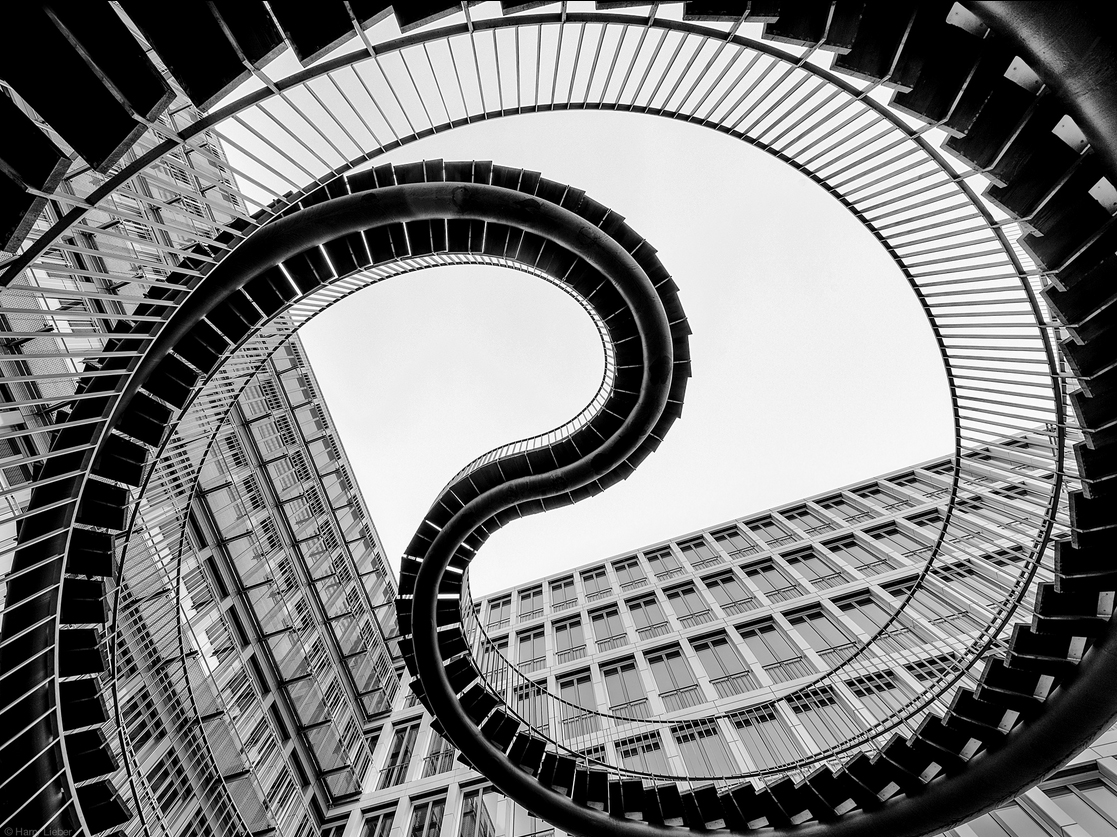 Curve
Curve
A telephoto lens with about 70-200mm focal length (full frame) is an advantage to choose a smaller section of the subject, e.g. for photos of details. This can avoid the need for later cropping of the photo on the computer with eventual loss of quality. It may also be necessary that you need a longer focal length because you simply cannot get close enough to the subject. My photos "The break", "Balconies" and "Veneer” were taken with a telephoto lens.
If the camera does not have a swiveling screen, I recommend purchasing an angle-viewfinder. With this you take photos from extreme positions. In my picture "Bricks" an angle-viewfinder was used. For this image you can find a detailed tutorial on 1x.com.
For long exposures a good tripod is essential. For shorter exposure photos I do not use a tripod and I had never any issues regarding image equality / image sharpness. None of my images shown here were made with a tripod.
Very expensive special lenses for architectural photography correct converging lines during the shoot. I do not use them, because this can nowadays be corrected easily by software and this solution is therefore much cheaper.
Can you explain how you go about approaching and photographing your subjects? How do you prepare for shooting at a specific location?
Generally, I see my own photography in four phases:
1. Preparation
2. Taking photos on site
3. Selecting the best images and performing the image processing
4. Sharing my photo with others
I forego the preparation only rarely. Although it is sometimes fun to go out and search for subjects without any preparation. The yield of good pictures is then fairly random. Nevertheless, I do it from time to time because you get the possibility to find objects that others have not yet photographed. Also you can find objects which you would not have found just by preparation via the internet. The staircase of "Helical stair" I found by accident in Basel after I'd walked rather aimlessly through the city for hours and didn’t find any exciting object - I am glad I did not give up prematurely.
If I want to photograph the architecture of a city, I investigate mainly via the Internet. I look in various forums for photography or architecture. Additionally I just search for keywords via Google. If I find an interesting object, I add it to the list. If the list is complete, I look via Google Maps for the exact location in the city. Then I create one or more tours. Depending on the season, I keep the expected lighting conditions in mind. For example, during a tour in the summer I take pictures of stairs inside the house preferably around noon. Because during noon taking photos of outside architecture usually is rather inappropriate since the light would be too harsh.
For the photo shoot preparation of some objects it would be necessary to check the photography permission in advance. This way it cannot come to nasty surprises on site, because photography is not allowed or only with advanced reservation. In any case, I consider good preparation as very important; it saves time for the essentials.
The composition is essential for architectural photography. Tell us how you manage a perfect composition once you're at the chosen location ?
Even though I know what photos I can expect for many of the objects, I check out the object without taking pictures or at least I'm just taking a few test photos. So I get an impression of the object and do not oversee anything. I check the object with a "wide angle view" and a "tele-photo view" and have several pictures already in my mind, before I look through the viewfinder.
Finding the best perspective and framing are essential.
If I have found a good place for a desired photo, first I mount the lens on the camera and then I adjust the camera settings. Usually I take pictures in the mode "Aperture Priority" and in most cases I activate the Auto-ISO. Depending on the subject and lighting conditions I set an exposure compensation. Now I use the camera and look through the viewfinder. I often have to correct my position a little bit to get the best perspective. Since I work exclusively with zoom lenses, I can set the framing mostly by adjustment of the focal length. Then I take a first photo and look at the camera screen in particular to avoid overexposure. If necessary, I adjust the exposure compensation.
Once the setting seems to be okay, then I can concentrate on capturing the image. As said above, I already have a desired picture composition in mind. Every now and then there occurs a new or better idea when looking through the viewfinder,because sometimes you just have previously not seen the whole object.
Finally I take a few photos of the entire architectural object for my own documentation. So that I later have a reminder of how it was at site. Also having these documentary photos comes quite handy if I want to visit the same place again.
What gear and software do you use ?
I use Nikon full-frame cameras and Nikon full-frame lenses for many years. Until recently, I have photographed with the NIKON D800, previously with the Nikon D700. After the launch of the Nikon D750, I have switched to this model,because this is the first full-frame Nikon camera with a swiveling screen. And this was what I had been missing with the Nikon D700 and D800 quite often. The mounting of an angle-viewfinder was very laborious for the D700 and the D800. And a swiveling screen can often be more readily used than an angle-viewfinder.
My lenses are:
- NIKKOR AF-S 16-35 / 4 G ED VR
- NIKKOR AF-S 24-70 / 2.8 G ED
- NIKKOR AF-S 70-200 / 4 G ED VR
As previously stated, it is not absolutely necessarily to use such a relatively high-quality and expensive equipment, at least for the start. A few of my pictures are even taken with the NIKON travel zoom lens AF-S 28-300 G VR ("The break" and "Shadow play"). This works too, even though it has its limits. But the demands on picture quality and comfort are rising. Essential for the lenses are their optical performance regarding sharpness, contrast and distortion. With high quality equipment those areas are all covered. Additionally with high quality equipment, you have significantly more reserves when having only little available light – in those situations you can use the performance of the lenses and the high ISO capabilities of the camera.
On photo tours I save every evening my photos of the day on my laptop and in addition to a 2.5” external hard drive. With the dual saving, I have a good level of security and I never lost images until now. Mostly I am viewing the pictures of the day in the evening and make already a pre-selection of the best images I would like to process later at home.
I shoot in RAW,to get the best quality, especially regarding saving details in the lights and recovering details in the shadows. One has more control over noise and sharpness. I work with ADOBE Photoshop CS6 Extended. The files I manage with the "Bridge", the RAW conversion I do with "Camera Raw" and the processing of the photos with "Photoshop". I work with a Windows PC and a calibrated monitor.
Looking at the images in your portfolio, I've noticed that very often, there is one element in the pictures, apart from the main architectural subject that reinforces the overall impression: The sky ! Can you reveal a little how you get those dramatic skies ?
First of all: of course, for outdoor shots of architecture, it is often a matter of luck what kind of sky you find. If the sky does not fit, for example because it is to dazzling, I do not take any photos with content of sky.
I work with three different methods to emphasis the sky, and I will explain this on the basis of my images:
In "CLOUDS" and "Deep Space" you see the natural sky - only emphasized. I do it in this way, that I decrease the lights and increase the shadows with help of the RAW converter. Additional I darken in the RAW converter the blue tones and aqua tones a little. As with all controllers, I try not to exaggerate it. In Photoshop I used "Google Viveza2" to further darken the blue sky partially and to increase the details in the bright parts (clouds) in the image.
In "Escape" in the original image was a continuously blue sky. In the black and white conversion I have darkened the blue tones and Cyan tones extremely until they were black. The building I have masked before.
In "Bricks" it happened, that the camera was very close to the ground and the angle-viewfinder was mounted. A tripod or a camera pillow was not feasible. So it was not possible to make a long-term exposure for inclusion of the blurred sky. Anyway, the sky at this day was blue with no clouds. So I had to create the sky in Photoshop at home, as I painted with several different brushes and different shades of gray in the sky and modified this with the Gaussian Blur filter and the motion blur filter. I must say that I am not a friend of artificial sky and I do this only on rare occasions. But in this picture it was essential for finishing the image idea.
There is a distinct feel and look to the photographs that you have shown us. May I ask you about your thoughts on how your process works from the choices you make before you press the shutter till the choices you make in the digital darkroom ?
The main idea of my architectural photography is that a good picture should have a recognizable image idea. The image idea may well be recognizable only at second glance - the lady in "The break" you only discover upon closer viewing of the image. The difficulty now is that a visual idea as "aesthetics" is difficult to measure and pretty emotional and subjective. In order to be aesthetic, I see it as a very important prerequisite to have a crisp and coherent image framing.
So, before I press the shutter button, I look around in the viewfinder if I have what I want and I check if the framing is optimal. For the balance it is very important where you placed the image-important elements. I pay particular attention to the balance in the photograph.
It is quite beneficial to know basic photography rules such as the "golden ratio". Breaking this rules sometimes can make a photo more exciting or interesting: In my photo "Bird inspection" I placed the very important bird close to the edge of the picture - but it works and was a much better choice than placing the bird according to the “golden ratio”.
Before I press the shutter button, I also check to have as the least possible interfering elements in my photo. If interfering elements cannot be avoided, I wonder at this moment, if they can be eliminated by post processing. If yes, I press the button. If I'm not sure, I'm trying to change the framing. During changing the framing I press the shutter button several times. Here I postpone the decision whether the image could be a good one or not.
A good example regarding eliminating interfering elements is my picture "V", for which there is also a tutorial at 1x.com. In front of the building there were many electric cables for the tram (streetcar). For me there was no chance to take a photograph without these cables. I knew at site that it will be a lot of work to remove them later by post processing. I decided then to take the picture and prepare for a lot of work to be done. And I think it was worth it.
Most of my pictures are in black and white. But I also find it fascinating when I manage to get the colors of the architecture in the photo of the main element and those create the special aesthetics of the image. "The break", "Blue inner yard" and "A" and "Just wood and light" would hardly work as well in black and white.
You have found your own and unique style, Harry. What is your overall vision and approach to Fine Art Architecture Photography and are there more goals that you wish to achieve in the future?
The genre of architecture photography provides a wide field. I hope my work illustrates this. What probably most of my architectural images have in common, is a good image balance and framing, their aesthetics and their accuracy. Additionally you can see that modern architecture attracts me a lot. I love clear structures, shapes and lines. Curlicue are not my thing. Modern architecture gives me the opportunity to search for these elements.
My goals for the future are:
I want to find out how much more I can abstract my architectural photos and at the same time keep them aesthetic and appealing.
Another goal is to discover how far I could move away from the architecture in my photos so that the image can be nevertheless accepted as an architectural photo. My first attempt in this direction is the image "Static & dynamic"
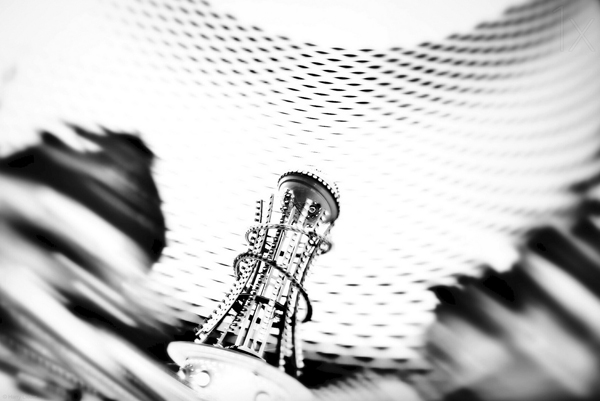 Static and dynamic
Static and dynamic
I see as another approach to extend my architectural photography composition with using the depth of field - which is currently not included in my architectural photography.
A further approach will be the use of motion blur for some objects as part of the composition in the photographs. As a first try see "Walking through the city"
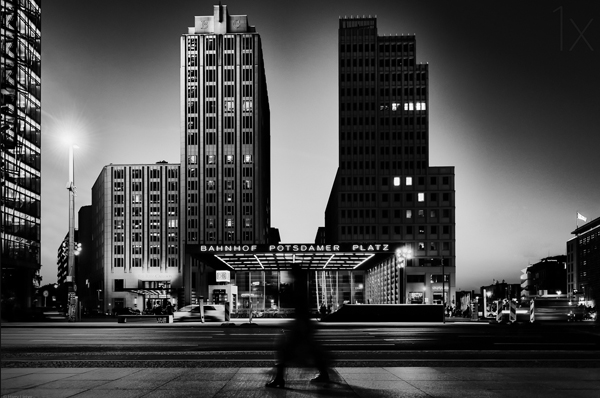 Walking through the city
Walking through the city
So overall some of my future photos perhaps may be not as aesthetically pleasing as before. But let’s see what will happen and how it works. As you can see, my goal is to further explore the broad field of architectural photography.
Thanks for this fine and inspiring interview, Harry.
Just one more question: may I ask your personal vision on 1X as a home base for your work and for more talented photographers in general?
It was an honor to me, Yvette. Thank you very much for the very pleasant interview and the possibility to present some of my photos in the 1X Magazine. As said before, I like 1x.com already as a very good and inspiring home base for architectural photographers. I would be very happy if more photographers find their joy in architectural photography.
 | Write |
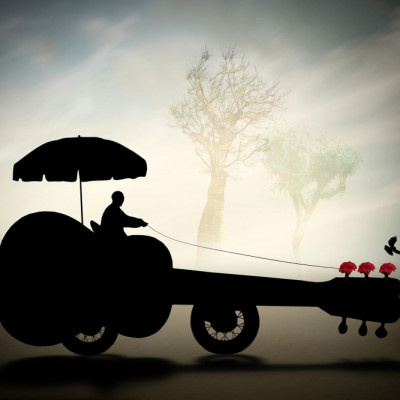 | Ben Goossens ✝ PRO It's not easy to make the difference in architecture: you do Harry:-)
Big thanks also to Yvette for the nice article.
Best, ben |
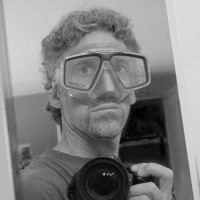 | JeffBaker Wow! An inspiring interview with an inspiring photographer. Thank you 1x and Harry Lieber for sharing this valuable information. |
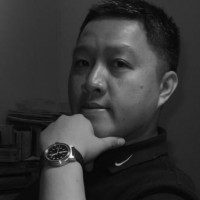 | Frederick Lim Cung Wei PRO Great article, Yvette. Harry is one of my idols. |
 | Edith Hoffman Great interview and work Harry, congratulations! Good to get to know you a bit better and enjoyed reading it. Compliments to Harry and Yvette. Enjoy your weekend and take care! Kind regards, Edith ;-) |
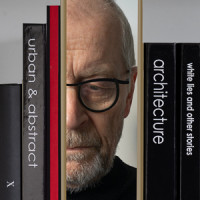 | Luc Vangindertael (laGrange) CREW Great interview for architecture lovers! Harry's work is a standard in creative architecture photography. Amazing coincidence: I stepped into photography (a second time) after my blues band stopped ... I wanted something else to fill up the free time in a creative way. First I intended to do landscape work, but I found out soon I was more attracted to architecture and abstract. |
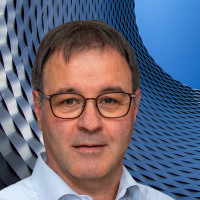 | Harry Lieber PRO Many thanks, Luc. Glad to hear that we had similar "reasons" to come to photography. I admire your architectural work a lot. |
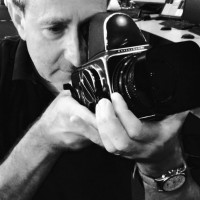 | Nick van Dijk I admire your style very much Harry!
Great interview again Yvette,
Best regards, Nick |
 | Harry Lieber PRO Thanks so much, Nick. This is great! |
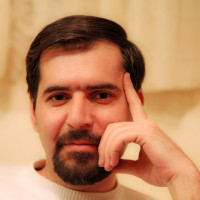 | Mohammad Soheilinia On the photo should be a master photographer of modern architecture and images in this collection is more specific lettering and shapes that play is connected with,
Thanks to all and BRAVO! |
 | Harry Lieber PRO Thank you very much, Mohammad. |
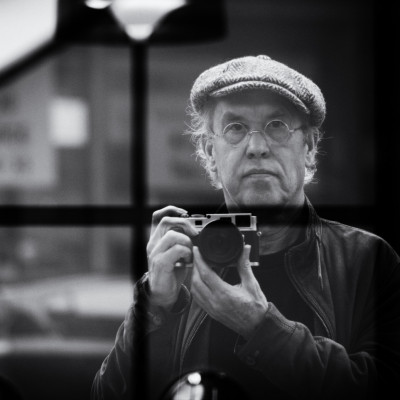 | Hans Martin Doelz CREW Enjoyed it already in the 1X-magazine No 2. Compliments to Harry and to Yvette for conducting the interview ! Cheers, Hans-Martin |
 | Yvette Depaepe CREW Thanks for your appreciation, Hans Martin ! All honor goes to Harry Lieber ... It was so great to interview him. Cheers, Yvette |
 | Hans Martin Doelz CREW I want to add that I regret it very much that the 1X-Magazine as it was published with ISSUU (Numbers 1-4) will no longer be published there. There are many restrictions / limitations with the new online blog that replaces the old magazine. I liked the fine layout in the (old fashioned) magazine very much. Cheers, Hans-Martin |
 | Harry Lieber PRO Many thanks Hans-Martin, glad to know you enjoyed the interview! |
 | Harry Lieber PRO Dear Yvette, again many thanks for the interview. It was a great pleasure to me to work with you! |
 | Harry Lieber PRO The magazine could be found here: https://1x.com/learning/?magazine=1
|